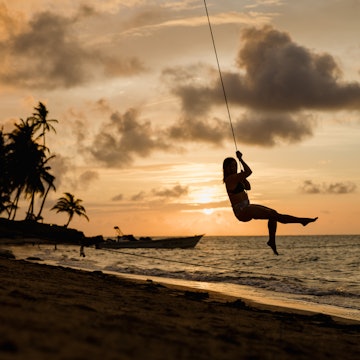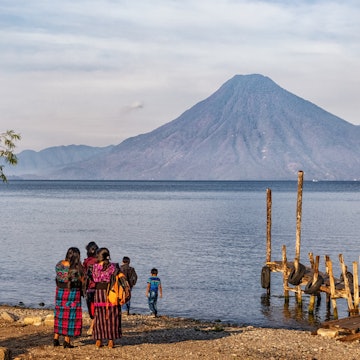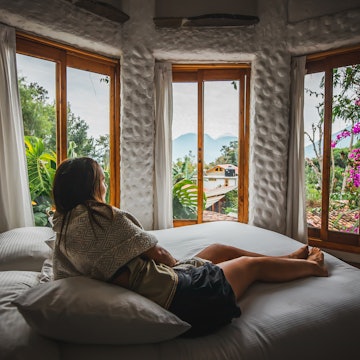

Traveling in Honduras requires a bit of savvy – here's what you need to know © Djavan Rodriguez / Shutterstock
The first time I visited Honduras, I was backpacking through Central America and heard Roatán was a cheap and beautiful place to dive. I planned on a few days. I ended up staying a month, diving every day, twice a day, not wanting to leave.
Since then, Honduras has called me back countless times: waterfalls and black sand beaches, cloud forests and Maya ruins, colonial towns and even backcountry travel in La Moskitia.
Sure, Honduras has a tough reputation. But if you keep an open mind and your wits about you, you’ll find the beauty and diversity of a place like no other. Here are a few tips to help you make the most of it.
1. Plan for at least one week
You’ll need a week to take in the highlights of this spectacularly diverse country. Though speedy, this will allow you to experience diving, snorkeling and beach time on the Bay Islands; white water rafting on the impressive Rio Cangrejal; and the Maya ruins of Copán and its charming cobblestone town.
With more time, you can explore Honduras’ coastal communities, highland villages, rainforests and even a few volcanoes.
2. Expect some rain
Honduras has two rainy seasons, but even so, the sun almost always makes a daily appearance. (March and April are the only consistently dry months).
Along the Caribbean coast, on Bay Islands and in La Moskitia, it’s wettest from October to February; in the interior and on the Pacific coast, the rain comes between May and October.
Hurricanes are rare, though flooding and mudslides in the highlands can shut down roadways. If you’re traveling country-wide, bring a waterproof jacket – chances are you’ll need it somewhere.

3. Pack layers and versatile shoes
The temperature doesn’t vary much by season but is dependent on the elevation. Honduras’ mountainous interior is temperate and even a little chilly in the evenings, while the coastal lowlands are hot and humid.
Pack with your destination in mind, making sure to bring layers. Even on the coasts, pants and long sleeves will help protect you against mosquitos and keep you warm on buses known for their arctic-cold air conditioning.
Bring good walking shoes or athletic sandals for sightseeing and outdoor adventure, especially ones that perform well in wet conditions. If you’re headed to the coasts or Bay Islands, flip-flops are a must.
4. Bring skin protection and snorkel gear
Bring mosquito repellent and sunscreen. While you can buy these items in Honduras, you’ll pay a premium. The same goes for snorkel gear, especially if you’ll be in the water more than a couple of times.
5. Leave valuables at home
Like most places in Latin America, it’s best to leave flashy items at home. Wearing jewelry, fancy watches and designer clothing makes you stand out, which could make you a target for petty thefts.
6. If you want to learn to dive, this the place
The Bay Islands offer some of the most affordable diving in the Western Hemisphere, from certification courses to fun dives.
Plus, it’s gorgeous. There are countless dive shops on Roatán and Utila, so research and choose one in advance so you don’t waste valuable vacay time on it – look for PADI or NAUI affiliation, small group sizes and good safety records.
Reputable dive shops on Roatán include Native Sons and West End Divers; in Utila, check out Alton’s Dive Center and Utila Dive Center.

7. Carry small bills and coins
Cash is king in Honduras, and the smaller the denomination, the better. ATMs are the easiest way to get lempiras; they’re found in all but the smallest of towns, and most don’t charge fees for out-of-network cards (though your own bank may apply a surcharge).
For safety, only use ATMs during the day and in secure locations like inside a bank or mall, where there are security guards.
Though lempiras are the preferred currency country-wide, US dollars, and sometimes euros, are accepted in well-touristed areas – just be sure they’re in good condition.
8. Credit costs extra
Visa and Mastercard are accepted at many midrange and high-end establishments, but expect a 5% to 10% surcharge. It adds up fast, but can be preferable to carrying large amounts of cash.
9. Prepare to hear (and use) more than Spanish
While Spanish is Honduras’ official language, English is more commonly used on the Bay Islands (which were one-time British colonies).
Five Indigenous languages are also spoken; Garifuna is the most popular, heard along the north coast in communities inhabited by the like-named Afro-Indigenous people.
10. Lean into long-distance bus travel
The easiest way to get around mainland Honduras is by bus (Viana Transportes and Hedman Alas are popular ones). Opt for directo (direct with minimal stops) or ejecutivo or lujo (non-stop) service, which are faster, safer coach-style buses; lujo buses also have powerful air-con and reclining seats.
If you’re pinching lempiras, take parando (stopping) service, refurbished school buses packed with people and packages that stop frequently.
If you’re traveling on a directo or lujo bus, stock up on treats at the bus station before the trip begins. If you’re taking a parando bus, vendors will step onto the bus to sell homemade snacks and bottled drinks along the way. Either way, you won’t go hungry!
Note: Bus service slows as the day progresses – aim to take an early bus so you don’t get stranded.
11. Say hola, hello or mábuiga
Hondurans are kind, easygoing people, but greetings are important. Whenever you enter a business or meet someone, be sure to say buenos días (good morning), buenas tardes (good afternoon) or buenas noches (good evening).
If you’re on the Bay Islands, greeting folks in English works; in Garifuna communities, mábuiga (hello) is always well received.

12. Remember to tip
A 10% tip is expected at nicer restaurants, but make sure gratuity or "servicio" hasn’t already been added to the bill. Tips aren’t common at comedores (simple restaurants) or cafes, but they are appreciated. Don’t forget to leave a little something for your hotel cleaners, dive masters and tour guides too.
13. Bargain sparingly
Haggling isn’t much of a sport in Honduras – prices tend to be fixed, even in markets and streetside stands. Some light bargaining is tolerated at family-run hotels and by small-town taxi drivers; keep in mind, though, that those extra lempiras likely mean a lot more to the vendors than to you.
14. Don’t flush your TP
While flush toilets are the norm in Honduras, the plumbing is often antiquated and can clog easily. If there’s a trash bin next to the toilet, place your toilet paper in it.
15. Be cautious in cities
Like most countries, Honduras’ big cities are where most crime occurs. Be especially careful in San Pedro Sula and Tegucigalpa, where gang violence is heightened. Though travelers are rarely targeted, it’s possible to be in the wrong place at the wrong time.
Stick to daytime sightseeing and walk along busy streets. Don’t take city buses, where there’s sometimes gang activity. In the evenings, take private cabs (instead of colectivos, which are shared with other passengers), even for short distances. And never buy, use, or even be around illicit drugs.
16. Petty theft happens
If a tourist experiences crime in Honduras, it’s often petty theft. Minimize the chance of being targeted by being aware of your surroundings, especially in crowded places like buses or markets, where pickpockets can easily strike.
Don’t flash cash or valuables. And avoid walking on lonely streets or beaches, especially at night.
17. Don’t drink the tap water
Only drink bottled or filtered water in Honduras. Avoid tap water for brushing your teeth too. No need to worry about ice at restaurants or bars, though - it’s made from purified water at commercial factories.
18. Keep mosquitos at bay
Malaria, dengue and zika, all mosquito-borne illnesses, are present in Honduras, especially along the north coast and Bay Islands. Fortunately, you can protect yourself quite easily by wearing mosquito repellant and sleeping with a mosquito net or air-conditioning.
It’s also a good idea to wear long sleeves and pants around sunrise and sunset, when mosquitoes are most active. Consider asking your doctor about anti-malarial meds before traveling too.
19. Remember your embassy
If you’re a victim of crime, need medical assistance or legal help, contact your embassy or consulate. Approximately 22 countries, including the US and Canada, have representatives in Honduras who can help you navigate problems or recommend providers.














